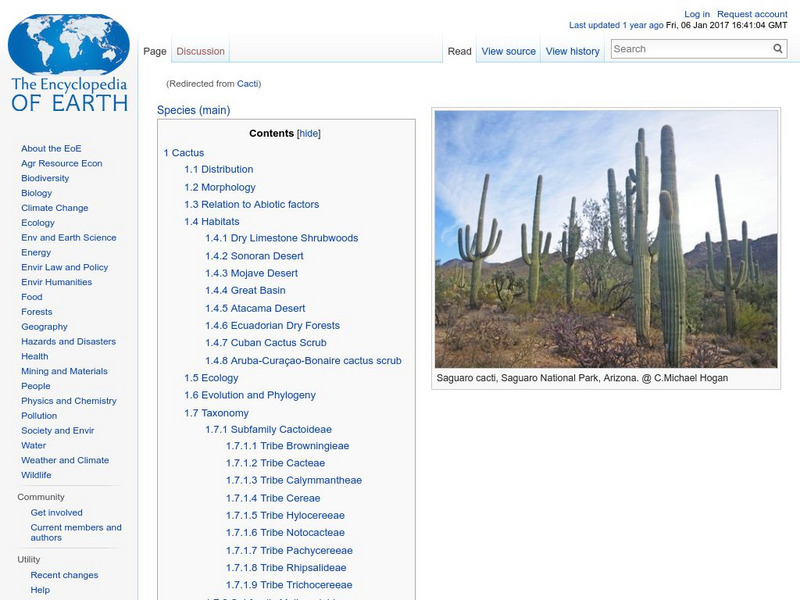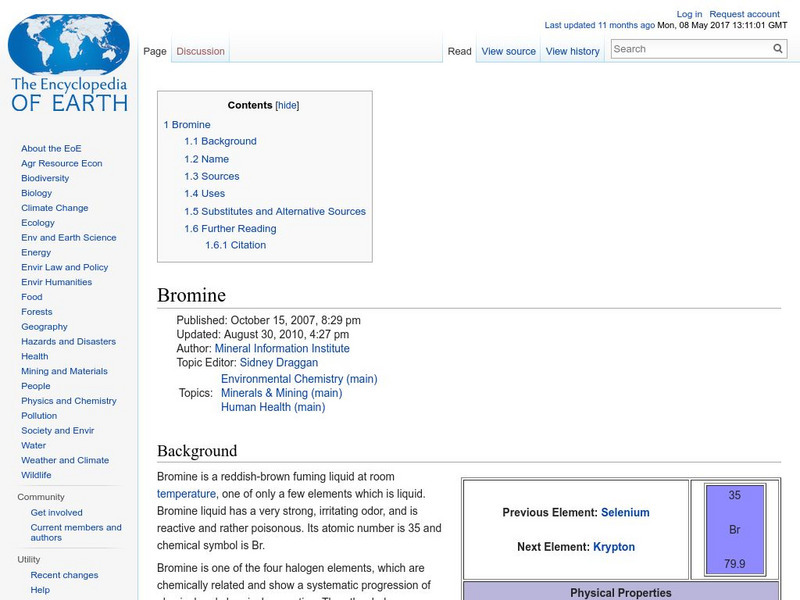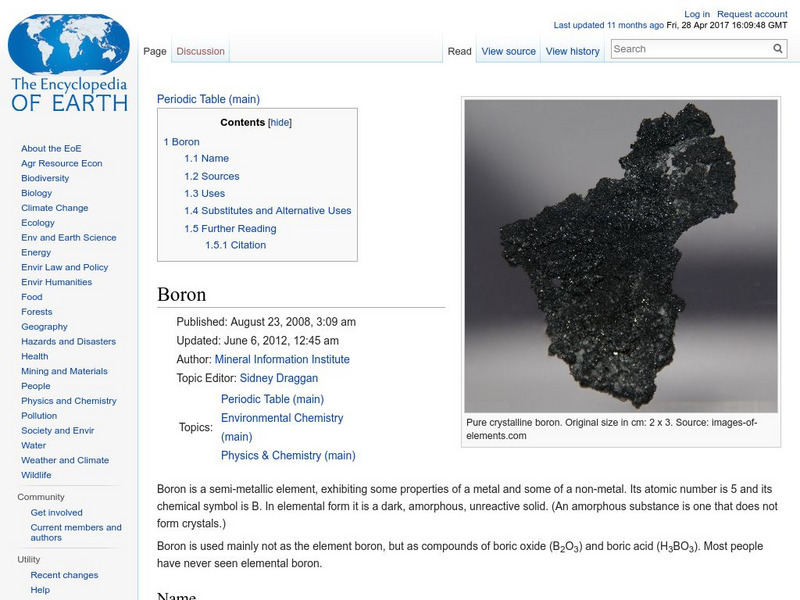Encyclopedia of Earth
Encyclopedia of Earth: Coal: Coal Fired Power Plants
Discuses how different types of coal-fired power plants work, and their advantages and disadvantages.
Encyclopedia of Earth
Encyclopedia of Earth: Einsteinium
Information about the man-made element, Einsteinium, atomic number 99. Covers physical and atomic properties, how it was discovered, its history, how it is produced, uses, and a list of its isotopes.
Encyclopedia of Earth
Encyclopedia of Earth: Environmental & Earth Science
A comprehensive resource of articles, videos, news and other research opportunities featuring environmental and earth science. References have been created by experts in the field and are useful for researchers and educators to enhance...
Encyclopedia of Earth
Encyclopedia of Earth: Microbiology: Dna
Describes the structure and coding of DNA, how it replicates, and the role it plays at the cellular level. Looks at past and current research on DNA, and applications of this research. (Published: September 25, 2010)
Encyclopedia of Earth
Encyclopedia of Earth: Curium
Information about the element, Curium, atomic number 96. Covers physical properties, atomic properties, how abundant it is on the Earth, and details about health-related regulations.
Encyclopedia of Earth
Encyclopedia of Earth: Copper
Information about the element, Copper, atomic number 29. Covers its history, sources, physical properties, atomic properties, how abundant it is on the Earth, details about permissible exposure, uses, and possible substitutes.
Encyclopedia of Earth
Encyclopedia of Earth: Cobalt
Information about the element, Cobalt, atomic number 27. Covers physical properties, atomic properties, how abundant it is on the Earth, and details about health-related regulations, and its importance to human and to animal health. Also...
Encyclopedia of Earth
Encyclopedia of Earth: Ocean Oil: Coastal Ecosystems
A collection of articles, video, and some teaching guides on issues related to coastal ecosystems. Includes environmental issues, e.g., oil spills, and different types of ecosystems, e.g., mangroves and coastal grasslands.
Encyclopedia of Earth
Encyclopedia of Earth: Chromium
Information about the element, Chromium, atomic number 24. Covers discovery, physical and atomic properties, how abundant it is on the Earth, permissible exposure limits, sources, uses, and potential substitutes.
Encyclopedia of Earth
Encyclopedia of Earth: Chlorine
Information about the element, Chlorine, atomic number 17. Covers physical properties, atomic properties, how abundant it is on the Earth, and details about health-related regulations.
Encyclopedia of Earth
Encyclopedia of Earth: Evolutionary Biology: Darwin, Charles
A biography of Charles Darwin.
Encyclopedia of Earth
Encyclopedia of Earth: Changjiang Plain Evergreen Forests
Describes the geography of the Chiangjiang Plain in China, its ecology, its conservation status, and threats to its biodiversity. (Published: August 3, 2007)
Encyclopedia of Earth
Encyclopedia of Earth: Cerium
Information about the element, Cerium, atomic number 58. Covers physical properties, atomic properties, how abundant it is on the Earth, and details about health-related regulations.
Encyclopedia of Earth
Encyclopedia of Earth: Cement
Describes what cement is, where it comes from, uses, and possible substitutes.
Encyclopedia of Earth
Encyclopedia of Earth: Physics & Chemistry: Catalysis
Gives definition of catalysis, an explanation of how it works, different kinds of catalysis and examples, substances that impact on the catalytic process, the many applications of catalysis, and a history of catalyst technology.
Encyclopedia of Earth
Encyclopedia of Earth: Human Health: Carcinogen
Gives definition of a carcinogen, examples, and the two categories of carcinogens - those known to cause cancer in humans, and those 'anticipated' to cause it.
Encyclopedia of Earth
Encyclopedia of Earth: Physics & Chemistry: Carbon Monoxide
A description of the chemical and physical properties of carbon monoxide, its toxic effect on humans, sources of this gas, and beneficial uses. Includes a list of safety resource websites.
Encyclopedia of Earth
Encyclopedia of Earth: Physics & Chemistry: Calcium
Information about the element, Calcium, atomic number 20. Covers physical and atomic properties, sources, its role in geochemical cycles, how abundant it is on the Earth, its isotopes, some compounds of calcium, and its importance to...
Encyclopedia of Earth
Encyclopedia of Earth: Cadmium
Information about the element, Cadmium, atomic number 48. Covers physical and atomic properties, how abundant it is on the Earth, sources, its presence in the environment, uses, substitutes, and health considerations.
Encyclopedia of Earth
Encyclopedia of Earth: Cactus
Describes the physical features of different cacti, the variety of habitats where they can live, their distribution, evolution, taxonomy, and conservation status. (Published: January 10, 2011)
Encyclopedia of Earth
Encyclopedia of Earth: Botany: Bumblebee
Article on the bumblebee. Covers physical features, life in a colony and as a pollinator, and threats to its survival. Includes links to additional resources. (Published: April 14, 2008)
Encyclopedia of Earth
Encyclopedia of Earth: Bromine
Information about the element, Bromine, atomic number 35. Covers physical properties, atomic properties, how abundant it is on the Earth, and details about health-related regulations. Discusses sources, uses, and substitutes.
Encyclopedia of Earth
Encyclopedia of Earth: Boron
Information about the semi-metallic element, Boron, atomic number 5. Covers physical and atomic properties, how abundant it is on the Earth, sources, uses, and possible substitutes.
Encyclopedia of Earth
Encyclopedia of Earth: Biomes: Borneo Montane Rainforests
Describes the geography of the Borneo montane rainforests, their biodiversity, conservation status, and the types of threats they face. (Published: December 8, 2006)

























